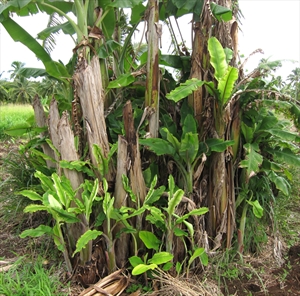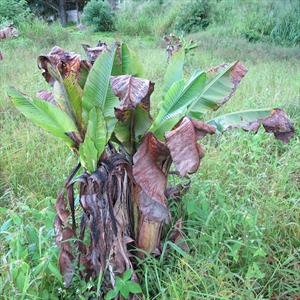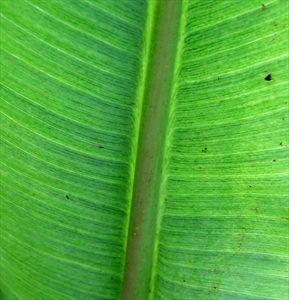- Worldwide distribution. On banana and plantains, and relatives, e.g., Heliconia.. Also, on Canna, ginger species, and aroids.
- Damage is done by the aphid spreading Banana bunchy top virus, after 18 hours’ feeding. Once aphid is infected, it stays infected until death.
- Natural enemies: beetles, lacewings, syrphids, parasitoid wasps.
- Cultural control: weed – remove alternate hosts; prune mats of unwanted suckers; plantains are tolerant, and Gros Michel is more tolerant than Dwarf Cavendish.
- Chemical control: if plant has BBTV, remove old leaves, then kill aphids by (i) soap, white or horticultural oils; (ii) derris or pyrethrum; (iii) synthetic pyrethroids; or (v) kerosene or diesel. Spray glyphosate, and after 1 week, remove plant and burn.
Pacific Pests, Pathogens and Weeds - Online edition
Pacific Pests, Pathogens, Weeds & Pesticides
Banana aphid (103)
Banana aphid
Pentalonia nigronerversa
AUTHOR Grahame Jackson
Information from Waterhouse DF, Norris KR (1987) Pentalonia nigronervosa Coquerel. Biological Control Pacific Prospects. Inkata Press; and DAF (2017) Banana aphid. Queensland Government. (https://www.daf.qld.gov.au/business-priorities/agriculture/plants/fruit-vegetable/insect-pests/banana-aphid); and from CABI (2019) Pentalonia nigronervosa (banana aphid). Crop Protection Compendium. (https://www.cabi.org/cpc/datasheet/39598). Photo 2 Richard Markham, ACIAR, Canberra.
Produced with support from the Australian Centre for International Agricultural Research under project PC/2010/090: Strengthening integrated crop management research in the Pacific Islands in support of sustainable intensification of high-value crop production , implemented by the University of Queensland and the Secretariat of the Pacific Community







